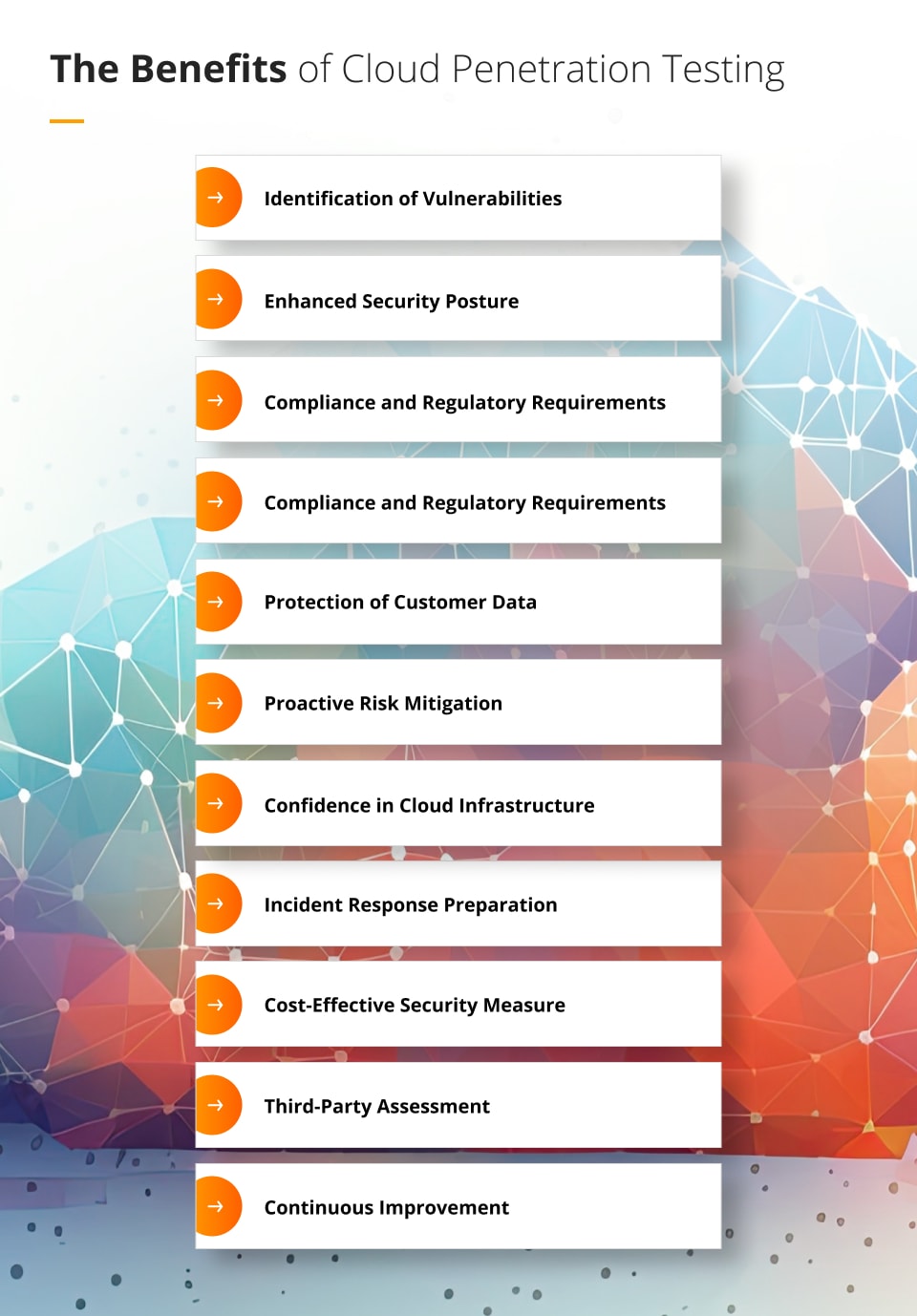
Cloud penetration testing: definition, benefits, and best practices
When moving to the cloud or starting a cloud-based business, it's very important to focus on cloud penetration testing and make sure it is done to the best standard.
What is cloud penetration testing?
It involves systematically probing and assessing the vulnerabilities and weaknesses within the cloud infrastructure, applications, and services by simulating a controlled cyber attack.
In cloud computing, organisations rely on third-party service providers to store and process their data, access applications, and utilise various cloud-based services. Cloud penetration testing aims to identify potential security flaws and risks within this cloud infrastructure to ensure the confidentiality, integrity, and availability of data and services, as well as opportunities for improvements.
What are the benefits of cloud penetration testing?
Cloud penetration testing is beneficial both to cloud service providers and to the clients using cloud to store sensitive data.
Some of the key advantages it offers include:
Identification of Vulnerabilities
Penetration testing helps identify vulnerabilities and weaknesses in cloud infrastructure, applications, and services. By discovering these vulnerabilities, organisations can take proactive steps to address them before they are exploited by malicious actors.
Enhanced Security Posture
Regular cloud penetration testing helps organisations strengthen their security posture by identifying and addressing security gaps. It allows them to fine-tune security controls, configurations, and policies specific to their cloud environment, thereby reducing the risk of security incidents and data breaches.
Compliance and Regulatory Requirements
Many industries have specific compliance regulations, such as GDPR, HIPAA, or PCI DSS, that organisations must adhere to when using cloud services. Penetration testing helps validate compliance with these requirements and avoid penalties for non-compliance, and ensures that sensitive data is adequately protected within the cloud environment.
Protection of Customer Data
Cloud service providers often store and process sensitive customer data. Conducting penetration testing assures customers that their data is being handled securely and that the provider has taken appropriate measures to protect it.
Proactive Risk Mitigation
Penetration testing allows organisations to proactively identify and mitigate risks before they are exploited. By staying ahead of potential threats and addressing vulnerabilities promptly, organisations minimise the likelihood and impact of security incidents.
Confidence in Cloud Infrastructure
Cloud penetration testing provides assurance to organisations and stakeholders that their cloud infrastructure is secure. It increases confidence in the cloud environment’s reliability, availability, and resilience.
Incident Response Preparation
Penetration testing helps organisations refine their incident response plans and procedures. By simulating real-world attack scenarios, organisations can test their incident response capabilities and identify areas for improvement.
Cost-Effective Security Measure
While penetration testing requires investment, it is a cost-effective security measure compared to the potential financial and reputational damage caused by a successful cyber attack. By proactively identifying and fixing vulnerabilities, organisations can save costs associated with remediation, incident response, and regulatory fines.
Third-Party Assessment
Cloud penetration testing enables organisations to assess the security practices of their cloud service providers. By conducting independent tests, organisations gain insights into the security measures implemented by vendors and ensure they meet their specific requirements.
Continuous Improvement
Penetration testing is not a one-time activity; it should be conducted periodically to adapt to evolving threats and changes in the cloud environment. By regularly testing and remediating vulnerabilities, organisations can continuously improve their cloud security posture.
How does cloud penetration testing differ from penetration testing?
Although cloud penetration testing and penetration testing (also known as network or application penetration testing) share similarities in their objectives and methodologies, they differ in their focus and scope.
To explain it in a more approachable way, penetration testing means performing security tests on a system, service or network with the aim of identifying security weaknesses. Cloud penetration testing means performing a simulated attack on all your services in cloud.
Common cloud security vulnerabilities
According to the recent statistics, 45% of breaches are cloud-based, and 80% of companies have experienced at least one cloud security incident in the last year. The most common cloud security vulnerabilities include:
Insecure APIs and interfaces
Cloud services often provide interfaces and APIs for managing and interacting with the cloud environment. Inadequately secured or poorly designed, they can be exploited by attackers to gain unauthorised access, manipulate data, or launch attacks against the cloud infrastructure.
Resource misconfigurations
Misconfigurations occur when cloud resources, network components, virtual machines, or containers are set up with incorrect or insecure configurations, allowing attackers to exploit weaknesses and gain unauthorised access.
Weak credentials or access management
Weak or misconfigured credentials (such as common or weak passwords) can lead to unauthorised access and data breaches. Insufficient authentication, weak password policies, excessive user permissions, and improper user provisioning and deprovisioning processes are examples of IAM vulnerabilities.
Outdated software
Many software vendors do not have a good updates procedure, and when software used in the cloud (including operating systems, applications, and libraries) is not regularly updated with the latest security patches and bug fixes, it becomes susceptible to known vulnerabilities.
Insecure coding practices and data breaches
Inadequate data encryption, improper data segregation, and weak access controls on stored data can lead to data breaches. Attackers may exploit these vulnerabilities to access sensitive data or manipulate data stored within the cloud.
Cloud pentesting methodology
Cloud penetration testing follows a systematic methodology to identify vulnerabilities and assess the security posture of cloud-based infrastructure, applications, and services.
A general outline of such a methodology is as follows:
- scope definition,
- information gathering,
- threat modeling,
- vulnerability scanning,
- manual testing,
- exploitation and post-exploitation,
- data security and privacy assessment,
- reporting and documentation,
- remediation and follow-up.
Three different approaches to conducting penetration testing are Black Box Penetration Testing, White Box Penetration Testing, and Grey Box Penetration Testing. All of them differ in terms of the tester’s knowledge and access to information about the target system:
- In a Black Box Penetration Test, the tester has no prior knowledge or access to internal details of the target system.
- In a White Box Penetration Test, the tester has full knowledge and access to internal details of the target system.
- Grey Box Penetration Testing lies between the Black Box and White Box approaches. In a Grey Box Penetration Test, the tester has partial knowledge and access to the target system.
Performing step-by-step cloud pentesting
Performing a step-by-step cloud penetration testing involves a systematic approach to assess the security of cloud-based systems, applications, and infrastructure.
Here’s an outline of the steps involved:
Step 1: Understand the cloud service provider policies
Understanding the cloud service provider policies and security controls is crucial in assessing the overall security posture, identifying shared responsibilities and aligning the testing approach accordingly.
Step 2: Identifying Potential Vulnerabilities
Cloud penetration testing involves identifying potential vulnerabilities in cloud-based systems, applications, and infrastructure. Some key areas to focus on when doing it include:
- configuration weaknesses,
- authentication and authorisation,
- insecure APIs and interfaces,
- data exposure and leakage,
- vulnerable components and software
- serverless architectures,
- network security,
- compliance and regulatory requirements,
- third-party integrations.
Step 3: Create a Cloud Penetration Testing Plan
A cloud penetration testing plan should include defining the scope, objectives, methodology of the testing engagement, pre-assessment activities, developing a testing plan, performing information gathering and vulnerability assessment and manual testing, documenting of findings and generating of reports.
It’s important to remember that each cloud penetration testing engagement may have unique requirements, so it’s crucial to tailor the plan accordingly.
Step 4: Execute the Plan
When it comes to actually executing the plan, engaging with experienced penetration testers or security professionals can provide valuable guidance and ensure the effectiveness of the testing process.
Step 5: Detect and Fix Vulnerabilities
Detecting and fixing vulnerabilities identified during cloud penetration testing is crucial to improving the security of the cloud environments. Handling vulnerabilities include prioritising them, developing a remediation plan, applying security patches and updates, configuring security controls, hardening applications and systems, enhancing access controls, secure data handling, test remediations and monitoring and updating.
Let experts find security gaps in your cloud infrastructure
No matter the industry you’re in, the security of your cloud infrastructure is always of paramount importance. At Future Processing we have a huge experience of performing cloud penetration testing for a variety of clients, from small businesses to large companies. Let our experts find security gaps in your infrastructure and help you improve your security posture.






